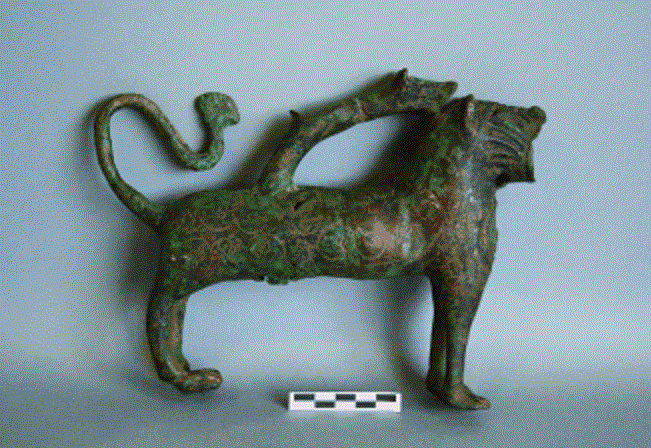Ebbene, sì: ora è possibile datare i metalli, con la voltammetria. Una datazione incrociata di vari oggetti ne ha dimostrato l'effidabilità (vedi: http://it.wikipedia.org/wiki/Voltammetria).
Spero quindi che smetterete - una volta e per tutte - di scassarci metodicamente i cabbasisi con la datazione inventata delle tavolette di
Tzricottu (*).
(*) Ne esiste una solamente, è in metallo: è stato dimostrato che 'le altre' sono solamente calchi in gesso malamente falsificati dall'unico esemplare realmente esistente (perché sono troppo simili alla prima ed unica 'tavoletta': più esatto sarebbe chiamarla 'matrice'). Inoltre, non si tratta affatto di scrittura, bensì di una decorazione (simmetrica! mai nessuna scrittura al mondo è stata simmetrica), da trasferire su cuoio.
La fattura farebbe infatti propendere per uno stampo medioevale.
Da notare che dette tavolette sono visibili solamente in fotografia. Viene proprio da pensare che le somiglianze con il fatto dell'uomo di Piltdown siano davvero troppe!
E che basarsi 'scientificamente' su tale materiale sia più adatto ad un ciarlatano...
Tzricottu (*).
(*) Ne esiste una solamente, è in metallo: è stato dimostrato che 'le altre' sono solamente calchi in gesso malamente falsificati dall'unico esemplare realmente esistente (perché sono troppo simili alla prima ed unica 'tavoletta': più esatto sarebbe chiamarla 'matrice'). Inoltre, non si tratta affatto di scrittura, bensì di una decorazione (simmetrica! mai nessuna scrittura al mondo è stata simmetrica), da trasferire su cuoio.
La fattura farebbe infatti propendere per uno stampo medioevale.
Da notare che dette tavolette sono visibili solamente in fotografia. Viene proprio da pensare che le somiglianze con il fatto dell'uomo di Piltdown siano davvero troppe!
E che basarsi 'scientificamente' su tale materiale sia più adatto ad un ciarlatano...
New method for dating copper and bronze artefacts
Spanish and Portuguese scientists have now introduced a technique for dating artifacts made of copper and bronze. Presented in the journal Angewandte Chemie, their electroanalytical method is based on the voltammetry of microparticles. It compares various corrosion products that form over long periods of time and works with only a few nanograms of material so it causes almost no damage.
Voltammetry of microparticles used to date archeological artefacts made of copper and bronze [Credit: © Wiley-VCH]
Voltammetric experiments produce current–voltage curves that have characteristic shapes for many compounds. In order to date copper-containing, archaeological finds, a team led by Antonio Doménech-Carbó at the University of Valencia examined the ratios of two different copper oxides, tenorite and cuprite, that can be differentiated and quantified based on their voltammetric curves. When they are exposed to air, copper surfaces become covered by a natural layer of cuprite (Cu2O). Over time, this layer is slowly converted to other products of corrosion. As copper-containing objects age in a slightly corrosive environment, without contact with soils or sea air, a layer of tenorite (CuO) continuously forms over the primary cuprite patina.
This occurs because cuprite reacts with oxygen from the air to preferentially form tenorite in an atmosphere containing CO2 or in the presence of calcareous materials. Examination of copper coins by scanning electron microscopy coupled with X-ray spectroscopy confirmed the presence of cuprite and tenorite.
To carry out the electroanalytical experiments, the researchers impregnate a graphite bar electrode with paraffin and dab the surface of the artifact with it. A few nanograms of the sample surface stick to the electrode, which is then dipped into an aqueous electrolyte.
This causes almost no damage to the object. Copper oxide microparticles result in very characteristic peaks in the resulting current–voltage curves. Of particular interest to the researchers is the ratio of the current peaks for tenorite and cuprite. It shows a steady increase with increasing corrosion time, as demonstrated with a series of antique coins from various collections, including the Prehistory Museums of València and Xàtiva (Spain), as well as the artificial ageing of Euro cent coins made of copper.
The researchers were able to use the coins to establish a calibration curve that can be used to date objects of unknown age. The voltammetric dating of a water pitcher from the Caliphal period and a Montefortino helmet from the Roman age gave ages of 1050±80 and 2150±150 years, respectively, which agree well with dates previously established from the archaeological context.
Source: Angewandte Chemie [July 11, 2014]
